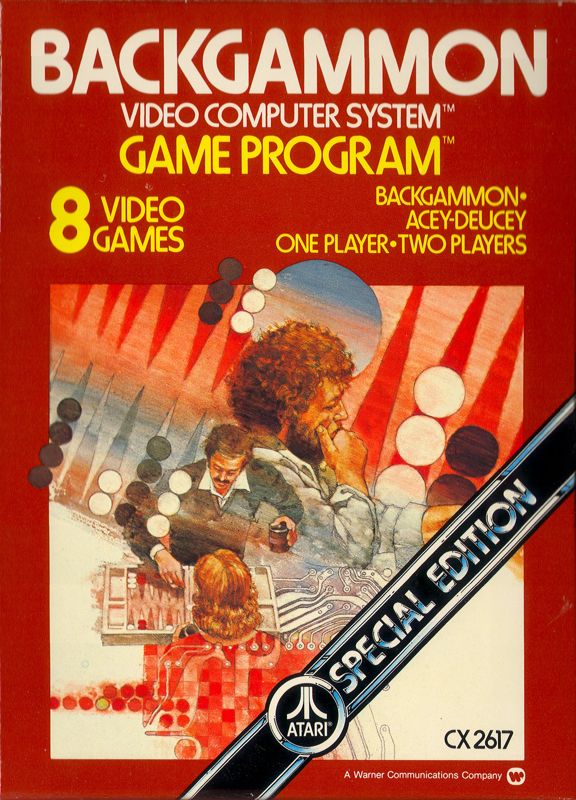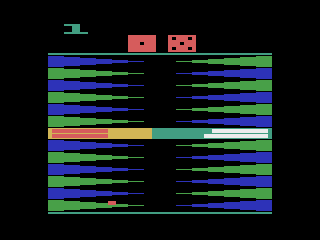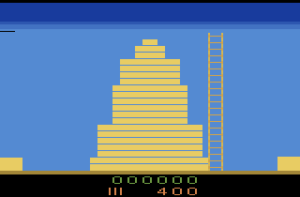Retro Replay Review
Gameplay
Backgammon on the Atari stays true to the venerable board game’s core mechanics, offering both the classic match and the spirited Acey Deucey variant. If you’re new to backgammon, you’ll appreciate that the standard rules—while long and complex—are faithfully reproduced here. The manual provides a full breakdown, so beginners and veteran players alike can reference every nuance, from bearing off to hitting blots.
The Acey Deucey variant ramps up the excitement by placing all pieces on the central bar at the start. You can enter any piece at any time simply by rolling the dice—no need to prioritize pieces sent to the bar. When you roll a 1-2 (an “acey-deucey”), you first make that move, then choose any doublet to play, and you earn an extra roll. If you hit another 1-2 on that bonus roll, the cycle repeats, letting you chain powerful sequences.
Difficulty switches add another layer of flexibility. On the right toggle, setting A delegates dice rolls to the computer, while B lets you physically roll real dice and enter the results yourself. The left toggle on A configures the board automatically, whereas B allows you to position pieces manually before play begins. This customization ensures that both solo strategists and social players find a comfortable setup.
Eight distinct game slots further diversify your experience. Games 1, 3, 5, and 7 pit you against the computer; 2, 4, 6, and 8 are head-to-head. Slots 1–4 hold traditional backgammon matches, and 5–8 are reserved for Acey Deucey showdowns. To up the ante, games 1, 2, 5, and 6 feature the doubling cube—ideal for high-stakes gambits and heart-pounding comebacks.
Graphics
Graphically, this adaptation embraces the clean, bold palettes of the Atari era. The board’s triangular points stand out in contrasting colors, making it easy to track your checkers at a glance. Subtle shading gives each point a sense of depth, while checker pieces are bold enough to remain visible even during brisk matches.
Dice rolls are animated with a satisfying clatter, and the pips on each face are crisp and legible. Whether you let the computer roll or dial in your own throws, the visual feedback keeps the action clear. A miniature doubling cube icon appears when in play, flipping seamlessly to show the current stake multiplier.
Menus and on-screen prompts maintain a functional simplicity. While you won’t find flashy background art or dramatic cutscenes, the interface is thoughtfully laid out. Difficulty toggles and game-variation selections are accessible from a single screen, letting you dive into a match without needless complexity.
Overall, the graphics serve their purpose: to present an uncluttered, easy-to-read board that emphasizes strategy over spectacle. For fans of traditional tabletop games, this faithful visual representation will feel both nostalgic and effective.
Story
Backgammon itself predates recorded history, having been enjoyed by civilizations across millennia. While this digital version lacks a narrative campaign, it carries the spirit of those ancient contests. Every roll of the dice echoes seaside taverns, caravan crossroads, and family tables where fortunes were won and lost.
The Acey Deucey variant adds a colorful chapter, born aboard U.S. Navy ships where sailors developed their own spices of backgammon. Its free-wheeling rules capture the camaraderie and unpredictability of life at sea—one moment you’re hoisting pieces from the bar, the next you’re riding an “acey-deucey” storm of bonus moves.
Though there’s no woven plot, each session writes its own story. You’ll face the suspense of near-miraculous escapes after a surprise 1-2, or the tension of a doubling cube raising the stakes. In that sense, every game spins a narrative of risk, reward, and the age-old quest to outwit your opponent.
Overall Experience
Backgammon for Atari is a robust digital rendition that balances authenticity with accessible customization. Whether you’re settling in for a solo duel against the computer or challenging a friend to a late-night Acey Deucey skirmish, the game’s structure supports varied playstyles and skill levels.
The learning curve is gentle if you rely on the manual for standard rules, yet it quickly becomes a test of tactics with the Acey Deucey variant’s extra-roll frenzy. Difficulty switches and game slots ensure fresh matchups and replay value, while the absence of extraneous features keeps the focus squarely on strategy.
For collectors of classic board-game adaptations or Atari enthusiasts seeking a cerebral diversion, Backgammon delivers. It may not dazzle with cinematic flair, but its enduring gameplay, flexible options, and historical pedigree make it a worthy addition to any library of digital reconstructions.
 Retro Replay Retro Replay gaming reviews, news, emulation, geek stuff and more!
Retro Replay Retro Replay gaming reviews, news, emulation, geek stuff and more!







Reviews
There are no reviews yet.